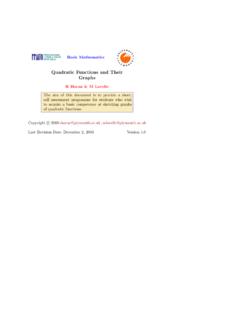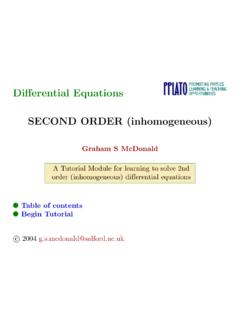Transcription of Differential Equations BERNOULLI EQUATIONS - …
1 Differential EquationsBERNOULLI EQUATIONSG raham S McDonaldA Tutorial Module for learning how to solveBernoulli differential equationslTable of contentslBegin Tutorialc of factor on using solutionsFull worked solutionsSection 1: Theory31. TheoryABernoulli differential equationcan be written in the followingstandard form:dydx+P(x)y=Q(x)yn,wheren6= 1 (the equation is thusnonlinear).To find the solution, change the dependent variable fromytoz, wherez=y1 n. This gives a differential equation inxandzthat islinear, and can be solved using the integrating factor : Dividing the above standard form byyngives:1yndydx+P(x)y1 n=Q(x) (1 n)dzdx+P(x)z=Q(x)(where we have useddzdx= (1 n)y ndydx).
2 TocJJIIJIBackSection 2: Exercises42. ExercisesClick onExerciselinks for full worked solutions (there are 9exercises in total)Exercise general form of a BERNOULLI equation isdydx+P(x)y=Q(x)yn,wherePandQare functions ofx, andnis a constant. Show thatthe transformation to a new dependent variablez=y1 nreducesthe equation to one that is linear inz(and hence solvable using theintegrating factor method).Solve the following BERNOULLI differential EQUATIONS :Exercise 1xy=xy2lTheorylAnswerslIF methodlIntegralslTipsTocJJIIJIBackSectio n 2: Exercises5 Exercise +yx=y2 Exercise +13y=exy4 Exercise +y=xy3 Exercise +2xy= x2cosx y2lTheorylAnswerslIF methodlIntegralslTipsTocJJIIJIBackSectio n 2: Exercises6 Exercise + tanx y=(4x+ 5)2cosxy3 Exercise +y=y2x2lnxExercise +y3cosecxlTheorylAnswerslIF methodlIntegralslTipsTocJJIIJIBackSectio n 3: Answers73.
3 : Firstly, divide each term byyn. Then, differentiatezwith respect toxto show that1(1 n)dzdx=1yndydx, x23+Cx, (C lnx) , (C 3x) , +Cx2, (sinx+C) , cosx(4x+ 5)3+Ccosx, +x(1 lnx) ,TocJJIIJIBackSection 3: cosx+ 4: integrating factor method94. integrating factor methodConsider an ordinary differential equation ( ) that we wish tosolve to find out how the variablezdepends on the the equation isfirst orderthen the highest derivative involved isa first it is also alinearequation then this means that each term caninvolvezeither as the derivativedzdxOR through a single factor such linear first order can be re-arranged to give thefollowing standard form:dzdx+P1(x)z=Q1(x)whereP1(x) andQ1(x) are functions ofx, and in some cases may 4.
4 integrating factor method10A linear first order can be solved using theintegratingfactor writing the equation in standard form,P1(x) can be then multiplies the equation by the following integratingfactor :IF=e P1(x)dxThis factor is defined so that the equation becomes equivalent to:ddx(IFz) = IFQ1(x),whereby integrating both sides with respect tox, gives:IFz= IFQ1(x)dxFinally, division by the integrating factor (IF) giveszexplicitly interms ofx, gives the solution to the 5: Standard integrals115. Standard integralsf(x) f(x)dxf(x) f(x)dxxnxn+1n+1(n6= 1)[g(x)]ng (x)[g(x)]n+1n+1(n6= 1)1xln|x|g (x)g(x)ln|g(x)|exexaxaxlna(a>0)sinx cosxsinhxcoshxcosxsinxcoshxsinhxtanx ln|cosx|tanhxln coshxcosecxln tanx2 cosechxln tanhx2 secxln|secx+ tanx|sechx2 tan 1exsec2xtanxsech2xtanhxcotxln|sinx|cothx ln|sinhx|sin2xx2 sin 2x4sinh2xsinh 2x4 x2cos2xx2+sin 2x4cosh2xsinh 2x4+x2 TocJJIIJIBackSection 5.
5 Standard integrals12f(x) f(x)dxf(x) f(x)dx1a2+x21atan 1xa1a2 x212aln a+xa x (0<|x|<a)(a>0)1x2 a212aln x ax+a (|x|>a>0)1 a2 x2sin 1xa1 a2+x2ln x+ a2+x2a (a>0)( a<x<a)1 x2 a2ln x+ x2 a2a (x>a>0) a2 x2a22[sin 1(xa) a2+x2a22[sinh 1(xa)+x a2+x2a2]+x a2 x2a2] x2 a2a22[ cosh 1(xa)+x x2 a2a2]TocJJIIJIBackSection 6: Tips on using solutions136. Tips on using solutionslWhen looking at the THEORY, ANSWERS, IF METHOD,INTEGRALS or TIPS pages, use theBackbutton (at the bottom ofthe page) to return to the the solutions intelligently. For example, they can help you getstarted on an exercise, or they can allow you to check whether yourintermediate results are to make less use of the full solutions as you work your waythrough the to exercises14 Full worked solutionsExercise +P(x)y=Q(x)ynDIVIDE byyn:1yndydx+P(x)y1 n=Q(x)SETz=y1 n: (1 n)y(1 n 1) (1 n)dzdx=1yndydxSUBSTITUTE1(1 n)dzdx+P(x)z=Q(x) +P1(x)z=Q1(x)linear inzwhereP1(x) = (1 n)P(x)Q1(x) = (1 n)Q(x).
6 Return to Exercise 1 TocJJIIJIBackSolutions to exercises15 Exercise is of the formdydx+P(x)y=Q(x)ynwherewhereP(x) = 1xQ(x) =xandn= 2 DIVIDE 1xy 1=xSETz=y1 n=y 1: y 2dydx= 1y2dydx dzdx 1xz= +1xz= xTocJJIIJIBackSolutions to exercises16 integrating factor,IF =e 1xdx=elnx=x xdzdx+z= [x z] = x33+CUsez=1y:xy= x33+ x23+ to Exercise 2 TocJJIIJIBackSolutions to exercises17 Exercise is of the formdydx+P(x)y=Q(x)ynwhereP(x) =1x,Q(x) = 1,andn= 2 DIVIDE +1xy 1= 1 SETz=y1 n=y 1: 1 y 2dydx= 1y2dydx dzdx+1xz= 1xz= 1 TocJJIIJIBackSolutions to exercises18 integrating factor, IF =e dxx=e lnx=elnx 1=1x 1xdzdx 1x2z= [1x z]= z= lnx+CUsez=1y:1yx=C (C lnx).
7 Return to Exercise 3 TocJJIIJIBackSolutions to exercises19 Exercise of the formdydx+P(x)y=Q(x)ynwhereP(x) =13Q(x) =exandn= 4 DIVIDE +13y 3=exSETz=y1 n=y 3: 3y 4dydx= 3y4dydx 13dzdx+13z= z= 3exTocJJIIJIBackSolutions to exercises20 integrating factor,IF =e dx=e x e xdzdx e xz= 3e x [e x z] = x z= x z= 3x+CUsez=1y3:e x 1y3= 3x+ (C 3x).Return to Exercise 4 TocJJIIJIBackSolutions to exercises21 Exercise equation:dydx+yx=y3withP(x) =1x,Q(x) = 1,n= 3 DIVIDE :1y3dydx+1xy 2= 1 SETz=y1 2:dzdx= 2y 12dzdx=1y3dydx 12dzdx+1xz= 2xz= 2 TocJJIIJIBackSolutions to exercises22 integrating factor, IF =e 2 dxx=e 2 lnx=elnx 2=1x2 1x2dzdx 2x3z= [1x2z]= ( 2) ( 1)1x+ 2x+Cx2 Usez=1y2:y2=12x+ to Exercise 5 TocJJIIJIBackSolutions to exercises23 Exercise is of the formdydx+P(x)y=Q(x)ynwherewhereP(x) =2xQ(x) = x2cosxandn= 2 DIVIDE +2xy 1= x2cosxSETz=y1 n=y 1.
8 1 y 2dydx= 1y2dydx dzdx+2xz= 2xz=x2cosxTocJJIIJIBackSolutions to exercises24 integrating factor, IF =e 2xdx=e 2 dxx=e 2 lnx=elnx 2=1x2 1x2dzdx 2x3z= [1x2 z]= z= z= sinx+CUsez=1y:1x2y= sinx+ (sinx+C).Return to Exercise 6 TocJJIIJIBackSolutions to exercises25 Exercise by 2 to get standard form:dydx+12tanx y=(4x+ 5)22 cosxy3 This is of the formdydx+P(x)y=Q(x)ynwhereP(x) =12tanxQ(x) =(4x+ 5)22 cosxandn= 3 TocJJIIJIBackSolutions to exercises26 DIVIDE +12tanx y 2=(4x+ 5)22 cosxSETz=y1 n=y 2: 2y 3dydx= 2y3dydx 12dzdx+12tanx z=(4x+ 5)22 tanx z=(4x+ 5)2cosxTocJJIIJIBackSolutions to exercises27 integrating factor, IF =e tanx dx=e sinxcosxdx[ e f (x)f(x)dx]=eln cosx= cosx cosxdzdx cosxtanx z=cosx(4x+5) cosxdzdx sinx z= (4x+ 5) [cosx z] = (4x+ 5) cosx z= (4x+ 5) cosx z=(14) 13(4x+ 5)3+CUsez=1y2:cosxy2=112(4x+ 5)3+ cosx(4x+ 5)3+ to Exercise 7 TocJJIIJIBackSolutions to exercises28 Exercise form:dydx+(1x)y= (xlnx) (x) =1x,Q(x) =xlnx,n= 2 DIVIDE byy2:1y2dydx+(1x)y 1=xlnxSETz=y 1.
9 Dzdx= y 2dydx= 1y2dydx dzdx+(1x)z= 1x z= xlnxTocJJIIJIBackSolutions to exercises29 integrating factor: IF =e dxx=e lnx=elnx 1=1x 1xdzdx 1x2z= [1xz]= lnxdx+C [Use integration by parts: udvdxdx=uv vdudxdx,withu= lnx,dvdx= 1 ] [xlnx x 1xdx]+CUsez=1y:1xy=x(1 lnx) + to Exercise 8 TocJJIIJIBackSolutions to exercises30 Exercise form:dydx (cotx) y= (cosecx)y3 DIVIDE byy3:1y3dydx (cotx) y 2= cosecxSETz=y 2:dzdx= 2y 3dydx= 2 1y3dydx 12dzdx cotx z= + 2 cotx z= 2 cosecxTocJJIIJIBackSolutions to exercises31 integrating factor: IF =e2 cosxsinxdx e2 f (x)f(x)dx=e2 ln(sinx)= sin2x.
10 Sin2x dzdx+ 2 sinx cosx z= 2 [sin2x z]= 2 ( 2) ( cosx) +CUsez=1y2:sin2xy2= 2 cosx+ cosx+ to Exercise 9 TocJJIIJIBack




